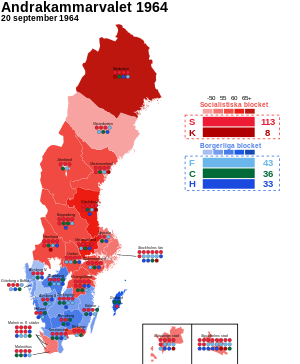1964 Swedish general election
Appearance
(Redirected from Swedish general election, 1964)
| ||||||||||||||||||||||||||||||||||||||||||||||||||||||||||||||||||||
All 233 seats in the Andra kammaren of the Riksdag 117 seats needed for a majority | ||||||||||||||||||||||||||||||||||||||||||||||||||||||||||||||||||||
|---|---|---|---|---|---|---|---|---|---|---|---|---|---|---|---|---|---|---|---|---|---|---|---|---|---|---|---|---|---|---|---|---|---|---|---|---|---|---|---|---|---|---|---|---|---|---|---|---|---|---|---|---|---|---|---|---|---|---|---|---|---|---|---|---|---|---|---|---|
| ||||||||||||||||||||||||||||||||||||||||||||||||||||||||||||||||||||
 Largest bloc and seats won by constituency | ||||||||||||||||||||||||||||||||||||||||||||||||||||||||||||||||||||
| ||||||||||||||||||||||||||||||||||||||||||||||||||||||||||||||||||||
General elections were held in Sweden on 20 September 1964.[1] The Swedish Social Democratic Party remained the largest party, winning 113 of the 233 seats in the Andra kammaren of the Riksdag.[2] Tage Erlander's Social Democratic government was returned to power.
Results
[edit] | |||||
|---|---|---|---|---|---|
| Party | Votes | % | Seats | +/– | |
| Swedish Social Democratic Party | 2,006,923 | 47.27 | 113 | –1 | |
| People's Party | 720,733 | 16.98 | 43 | +3 | |
| Right Party | 582,609 | 13.72 | 33 | –6 | |
| Centre Party | 559,632 | 13.18 | 35 | +1 | |
| Communist Party | 221,746 | 5.22 | 8 | +3 | |
| Christian Democratic Unity | 75,389 | 1.78 | 0 | New | |
| Civic Unity[a] | 64,807 | 1.53 | 1 | New | |
| Middle Parties[b] | 13,557 | 0.32 | 0 | New | |
| Other parties | 384 | 0.01 | 0 | 0 | |
| Total | 4,245,780 | 100.00 | 233 | +1 | |
| Valid votes | 4,245,780 | 99.35 | |||
| Invalid/blank votes | 27,815 | 0.65 | |||
| Total votes | 4,273,595 | 100.00 | |||
| Registered voters/turnout | 5,095,850 | 83.86 | |||
| Source: Nohlen & Stöver | |||||
Notes
[edit]- ^ Joint list of the three right-wing parties in Malmö. One of its elected candidates was a member of the Centre Party, but sat as an independent.[2]
- ^ Joint list of the Centre Party and People's Party that contested some constituencies.[3]
References
[edit]- ^ Dieter Nohlen & Philip Stöver (2010) Elections in Europe: A data handbook, p1858 ISBN 978-3-8329-5609-7
- ^ a b Nohlen & Stöver, p1872
- ^ Nohlen & Stöver, p1861





